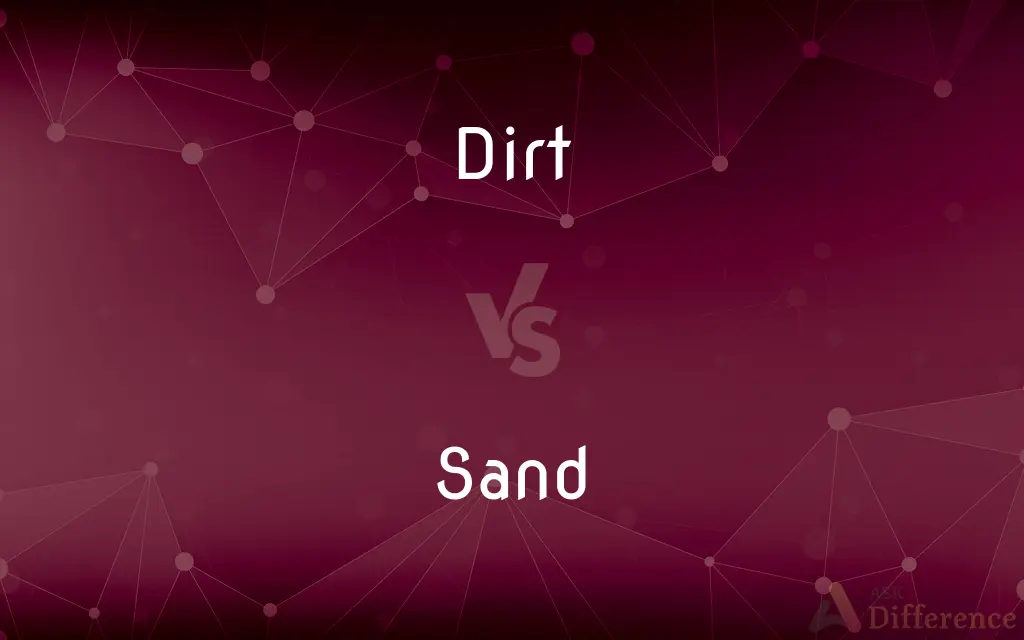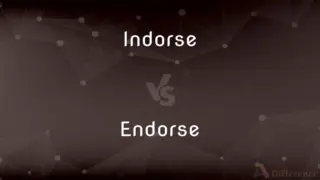Dirt vs. Sand — What's the Difference?
Edited by Tayyaba Rehman — By Fiza Rafique — Updated on November 6, 2023
Dirt is loose soil or earth; sand is a granular material composed of finely divided rock and mineral particles.

Difference Between Dirt and Sand
Table of Contents
ADVERTISEMENT
Key Differences
Dirt and sand are both terms that describe materials found on the Earth’s surface. Dirt, in general, is a broad term that often refers to soil or earth, encompassing various types of organic and inorganic matter. It can contain clay, silt, and organic matter, which makes it fertile for plant growth. In contrast, sand is more specific, consisting of fine particles of rock and mineral, typically quartz.
Sand is characterized by its coarseness, grain size, and its ability to drain water easily. It is not fertile like dirt because it lacks organic material. On the other hand, dirt can support plant life due to its nutrient content and is often darker in color due to organic matter. Sand, on the contrary, usually appears lighter, varying from white to tan to golden, depending on its composition.
The composition of dirt can vary greatly, having different textures and constituents in different areas. It's a mixture that includes decomposed matter which is essential for plant life. Sand is more uniform in composition, primarily silicon dioxide, and its granules are often more consistent in size. While you might find sand in dirt, you wouldn't classify all dirt as sand.
Dirt is often used in a broader sense, sometimes colloquially, to refer to any substance that is considered unclean or unwanted on surfaces like clothes or floors. Sand, however, conjures images of beaches and deserts and is rarely associated with uncleanliness. Moreover, sand has a range of uses in construction and manufacturing, such as making concrete, glass, and as a landscaping material.
The texture of dirt and sand can dictate their uses; for instance, the loamy dirt is prized for gardening while the gritty texture of sand makes it suitable for construction purposes. While sand can be a component of dirt, it does not offer the nutrients and water retention properties that plants require from dirt.
ADVERTISEMENT
Comparison Chart
Composition
Mix of organic matter, clay, silt, and sand
Coarse particles mostly of silica
Texture
Varies, can be fine to clumpy
Consistently grainy, fine to coarse particles
Color
Usually dark due to organic material
Light color, like white, tan, or golden
Fertility
Often fertile, supports plant growth
Infertile, does not hold nutrients
Uses
Gardening, filling, covering
Construction, landscaping, glass making
Compare with Definitions
Dirt
Any unclean substance, such as mud.
The car was covered in dirt after the rainstorm.
Sand
Material used in construction and crafts.
He mixed sand with cement to make concrete.
Dirt
A substance, like soil, considered waste.
There was a lot of dirt to clear from the construction site.
Sand
Coarse material that can be used to fill areas.
They used sand to fill the playground area.
Dirt
Material that soils something.
She wiped the dirt off the kitchen counter.
Sand
Sand is a granular material composed of finely divided rock and mineral particles. Sand has various compositions but is defined by its grain size.
Dirt
Dirt is unclean matter, especially when in contact with a person's clothes, skin or possessions. In such case they are said to become dirty.
Sand
Small loose grains of worn or disintegrated rock.
Dirt
Earth or soil.
Sand
(Geology) A sedimentary material, finer than a granule and coarser than silt, with grains between 0.06 and 2.0 millimeters in diameter.
Dirt
A filthy or soiling substance, such as mud or dust.
Sand
Often sands A tract of land covered with sand, as a beach or desert.
Dirt
Excrement.
Sand
The loose, granular, gritty particles in an hourglass.
Dirt
A squalid or filthy condition.
Sand
Sands Moments of allotted time or duration
"The sands are numb'red that makes up my life" (Shakespeare).
Dirt
One that is mean, contemptible, or vile.
Sand
(Slang) Courage; stamina; perseverance
"She had more sand in her than any girl I ever see.
In my opinion she was just full of sand" (Mark Twain).
Dirt
Obscene language or subject matter.
Sand
A light grayish brown to yellowish gray.
Dirt
Malicious or scandalous gossip.
Sand
To sprinkle or cover with or as if with sand.
Dirt
Information that embarrasses or accuses.
Sand
To polish or scrape with sand or sandpaper.
Dirt
Unethical behavior or practice; corruption.
Sand
To mix with sand.
Dirt
Material, such as gravel or slag, from which metal is extracted in mining.
Sand
To fill up (a harbor) with sand.
Dirt
Soil or earth.
Sand
(uncountable) Rock that is ground more finely than gravel, but is not as fine as silt (more formally, see grain sizes chart), forming beaches and deserts and also used in construction.
Dirt
A stain or spot (on clothes etc); any foreign substance that worsens appearance.
Sand
A beach or other expanse of sand.
The Canadian tar sands are a promising source of oil.
Dirt
Previously unknown facts, or the invented "facts", about a person.
The reporter uncovered the dirt on the businessman by going undercover.
Sand
Personal courage.
Dirt
(figurative) Meanness; sordidness.
Sand
A particle from 62.5 microns to 2 mm in diameter, following the Wentworth scale.
Dirt
(mining) In placer mining, earth, gravel, etc., before washing.
Sand
A light beige colour, like that of typical sand.
Dirt
Freckles
Sand
A single grain of sand.
Dirt
To make foul or filthy; soil; befoul; dirty
Sand
A moment or interval of time; the term or extent of one's life (referring to the sand in an hourglass).
Dirt
Any foul of filthy substance, as excrement, mud, dust, etc.; whatever, adhering to anything, renders it foul or unclean; earth; as, a wagonload of dirt.
Whose waters cast up mire and dirt.
Sand
(colloquial) A sandpiper.
Dirt
Meanness; sordidness.
Honors . . . thrown away upon dirt and infamy.
Sand
Of a light beige colour, like that of typical sand.
Dirt
In placer mining, earth, gravel, etc., before washing.
Sand
(transitive) To abrade the surface of (something) with sand or sandpaper in order to smooth or clean it.
Dirt
To make foul of filthy; to dirty.
Sand
(transitive) To cover with sand.
Dirt
The part of the earth's surface consisting of humus and disintegrated rock
Sand
To blot ink using sand.
Dirt
The state of being covered with unclean things
Sand
Fine particles of stone, esp. of siliceous stone, but not reduced to dust; comminuted stone in the form of loose grains, which are not coherent when wet.
That finer matter, called sand, is no other than very small pebbles.
Dirt
Obscene terms for feces
Sand
A single particle of such stone.
Dirt
Disgraceful gossip about the private lives of other people
Sand
The sand in the hourglass; hence, a moment or interval of time; the term or extent of one's life.
The sands are numbered that make up my life.
Dirt
(of roads) not leveled or drained; unsuitable for all year travel
Sand
Tracts of land consisting of sand, like the deserts of Arabia and Africa; also, extensive tracts of sand exposed by the ebb of the tide.
Dirt
Earth or soil, especially when loose.
The child's shoes were caked with dirt after playing outside.
Sand
Courage; pluck; grit.
Dirt
Informal term for scandalous gossip.
The magazine was known for spreading dirt on celebrities.
Sand
To sprinkle or cover with sand.
Sand
To drive upon the sand.
Sand
To bury (oysters) beneath drifting sand or mud.
Sand
To mix with sand for purposes of fraud; as, to sand sugar.
Sand
A loose material consisting of grains of rock or coral
Sand
French writer known for works concerning women's rights and independence (1804-1876)
Sand
Fortitude and determination;
He didn't have the guts to try it
Sand
Rub with sandpaper;
Sandpaper the wooden surface
Sand
Fine particles of crushed rock.
The sand on the beach was warm under our feet.
Sand
A loose granular substance often found in deserts.
The desert was an endless expanse of sand.
Sand
Small, gritty particles used for sanding.
The carpenter used sand to smooth the wood surface.
Common Curiosities
Can you grow plants in sand?
Sand alone is not suitable for most plants due to its lack of nutrients and poor water retention.
What is sand?
Sand is a granular substance composed of fine rock and mineral particles.
What makes sand different from other types of earth?
Sand's distinct fine granular texture and its primary composition of silica differentiate it from other types of earth.
What is dirt?
Dirt is loose soil or earth that can contain organic and inorganic material.
Can dirt be made up of sand?
Yes, dirt can include sand as part of its composition.
Can you find organic matter in sand?
Organic matter in sand is usually minimal or absent.
Where is sand typically found?
Sand is commonly found in deserts, beaches, and riversides.
Is sand better for drainage than dirt?
Yes, because of its coarse texture and large particle size.
Is dirt the same as soil?
Yes, dirt can be synonymous with soil, especially in a gardening context.
Are dirt and sand used the same way in landscaping?
Not typically; dirt is used for planting while sand is used for drainage and aesthetic purposes.
Is all dirt dark in color?
Not all; color can vary, but it's typically darker due to organic content.
Is sand used in making glass?
Yes, sand is a primary ingredient in glass making.
Do both dirt and sand have the same particle size?
No, dirt can vary widely, while sand particles are more consistent.
Can I use dirt to make concrete?
No, concrete requires specific proportions of sand, cement, and gravel.
Is beach sand considered clean?
While it's natural, beach sand can contain impurities and is not sterile.
Share Your Discovery

Previous Comparison
Indorse vs. Endorse
Next Comparison
Bungalow vs. HutAuthor Spotlight
Written by
Fiza RafiqueFiza Rafique is a skilled content writer at AskDifference.com, where she meticulously refines and enhances written pieces. Drawing from her vast editorial expertise, Fiza ensures clarity, accuracy, and precision in every article. Passionate about language, she continually seeks to elevate the quality of content for readers worldwide.
Edited by
Tayyaba RehmanTayyaba Rehman is a distinguished writer, currently serving as a primary contributor to askdifference.com. As a researcher in semantics and etymology, Tayyaba's passion for the complexity of languages and their distinctions has found a perfect home on the platform. Tayyaba delves into the intricacies of language, distinguishing between commonly confused words and phrases, thereby providing clarity for readers worldwide.













































